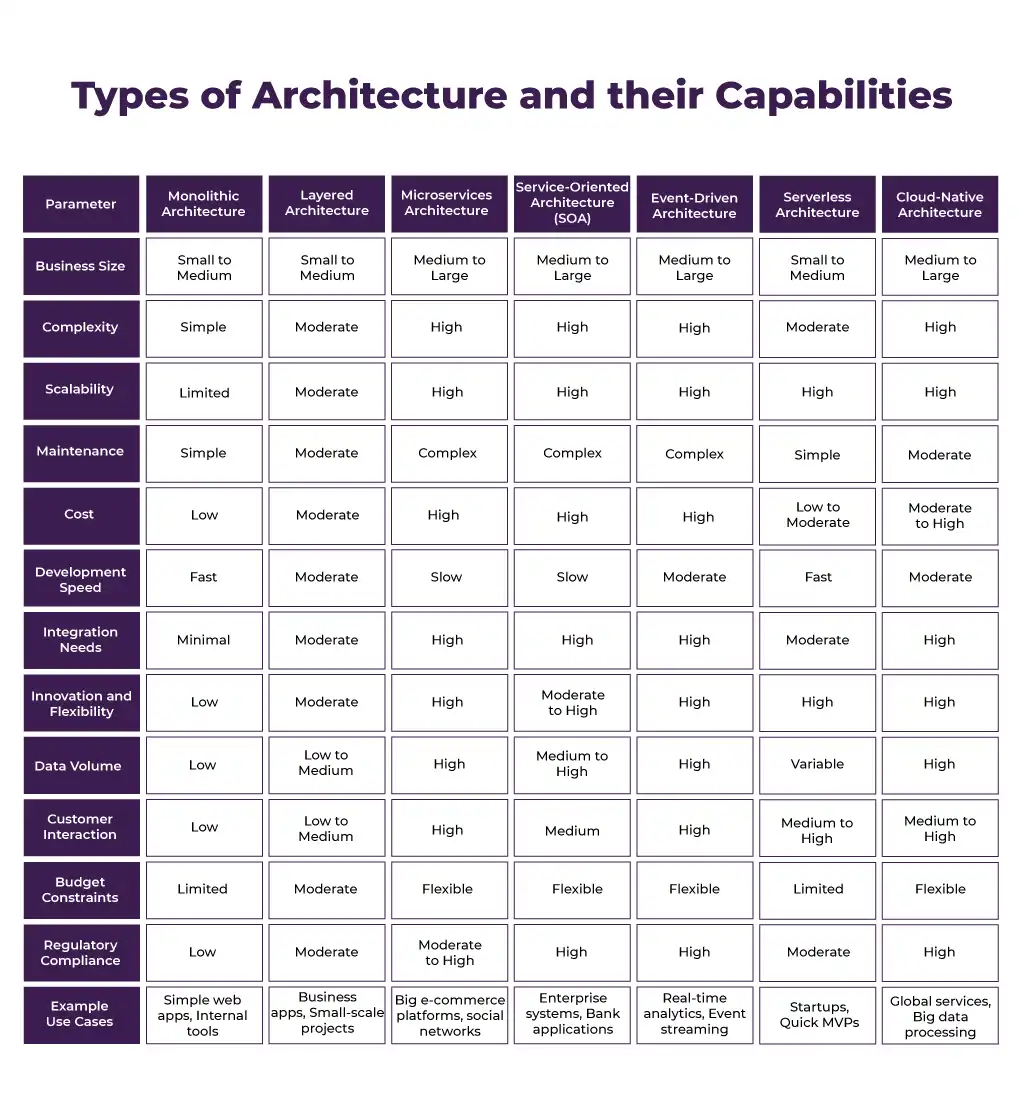If you were about to build a house, what would be the first and most important thing that you would pay attention to?
The Architecture – right?
And why not?
Besides location, the kind of living space where you are about to spend your life matters the most.
The space and the way it is designed have more impact on your day-to-day life!
In the same way – when it comes to business applications there are many important factors that can affect an app development!
But among all these factors – the one that can decide the fate of an application’s success is the – Architecture of an application!
Let’s get to know how important Architecture is for an Application!
How important is an Application Architecture?
Choosing the ideal and the best software architecture for your business is like making an investment that pays off in the long run.
Application architecture is extremely crucial as the success of your business and an application made for that purpose depends on it.
An Ideal architecture for a specific business application need ensures a sound technical foundation that leads to better-performing business solutions that are scalable and easy to maintain.
As the business grows the application should be flexible enough to adapt new features, modules and functionality that need to be developed and for that, the first step would be – having the right application architecture at the base.
Read more about the importance and:
Why you should not underestimate the power of an Ideal Application Architecture.
So, before we move on to understand how to choose the ideal one, let’s first identify some technical needs that a good application architecture satisfies.
Key technical requirements that a robust application architecture fulfils
1. Strong Foundation
An application’s architecture is like the blueprint of a house!
A well-designed architecture provides a solid foundation for your application, enabling it to scale, perform efficiently, and can be easily maintained as your business grows.
2. Scalability
Imagine a small store suddenly experiencing online shopping surges!
An ideal architecture ensures your application can handle increasing traffic and data volume.
A flexible architecture will adapt, whereas a poorly designed one might crash under pressure.
3. Performance
Think of a website that takes forever to load – Frustrated users will likely bounce off.
An application’s architecture directly impacts how fast and responsive your application will be.
A well-structured architecture minimises bottlenecks and ensures efficient data flow and component interaction leading to a smooth user experience.
4. Maintainability
Having a confusing interior of a house – that’s what poorly designed architecture can be like.
Good architecture makes your application easier to understand, modify, and troubleshoot.
It will be easy for future developers to maintain & scale the clear and organized code of an architecture that was chosen well.
5. Security
Imagine a house with weak locks and flimsy doors.
An architecture that ensures security minimizes vulnerabilities and protects your application from cyberattacks.
Similarly, an architecture, not suitable for your business needs can leave your application’s data exposed.
6. Cost-Effectiveness
Wasting money on regular fixes is something that we all should avoid!
Here, choosing the right architecture based on your business needs helps you save money in the long run as it would be built with the capacity to manage all the changing requirements of a business.
A poorly designed one might lead to costly rewrites, performance issues, and security breaches.
Now since you know how important an applications architecture is – now is the time to know how you can analyze which architecture you should consider!
To make it quick and easy to understand, below is the curated view, listed with software architecture types and different business parameters that can help you map the suitable application architecture with the business requirements.

After getting a brief knowledge about types of application architecture and their capabilities to serve application development requirements of different business sizes, let’s look into a detailed view of how to choose the right architecture.
This information is crucial to know if you are planning to build a new application or software or are Re-engineering a Product.
How to choose the best software architecture for your business application?
The easiest way to choose an architecture for your business application is by analyzing the nature, scope and growth potential of your business thoroughly while also ascertaining the capabilities of varied types of software architectures to conclude what’s best.
Consider factors like;
1. Business Size and Complexity
SMBs
- Monolithic Architecture – Simple to develop and deploy, ideal for limited resources.
- Layered Architecture – Organizes functions into layers, making maintenance easier.
Large Enterprises
- Microservices Architecture – Supports independent scaling and deployment of services, handling large-scale operations efficiently.
- Service-Oriented Architecture (SOA) – Facilitates integration across diverse systems, suitable for complex enterprise environments.
2. Growth Potential
Startups
- Serverless Architecture – No need to manage infrastructure, allowing rapid development and cost savings.
- Microservices Architecture – Enables quick iteration and scaling of individual services.
Established Businesses
- Layered Architecture – Provides a stable structure for long-term maintenance.
- Service-Oriented Architecture (SOA) – Supports scalability and integration of established systems.
3. Industry Requirements
E-commerce
- Microservices Architecture – Handles high traffic and frequent updates.
- Event-Driven Architecture – Processes transactions in real-time for a responsive user experience.
Healthcare
- Service-Oriented Architecture (SOA) – Ensures secure data exchange and regulatory compliance.
- Layered Architecture – Manages sensitive data securely and efficiently.
Finance
- Service-Oriented Architecture (SOA) – Ensures secure, compliant transactions.
- Microservices Architecture – Provides agility and resilience for financial operations.
4. Operational Scale
Local Businesses
- Monolithic Architecture – Cost-effective and manageable for small-scale operations.
- Layered Architecture – Structured approach for easy maintenance.
Global Enterprises
- Microservices Architecture – Supports global scalability and fault tolerance.
- Cloud-Native Architecture – Utilizes cloud services for elasticity and resilience.
5. Customer Interaction Level
High Customer Interaction
- Event-Driven Architecture – Real-time processing for a responsive experience.
- Microservices Architecture – Rapid updates and scaling of user-facing services.
Low – Medium Customer Interaction
- Monolithic Architecture – Simplifies development for internal tools if interactions increase.
- Layered Architecture – Organizes back-end functionalities for better management when interactions remain consistent.
6. Budget Constraints
Limited Budget
- Monolithic Architecture – Minimizes initial development costs.
- Layered Architecture – divides costs with incremental development.
Flexible Budget
- Microservices Architecture – Justifies higher initial investment with long-term scalability.
- Serverless Architecture – Reduces operational costs using cloud services.
7. Innovation and Adaptability
Highly Innovative Fields
- Microservices Architecture – Supports continuous integration and deployment.
- Event-driven architecture – Real-time responsiveness for innovative applications.
Stable Industries
- Layered Architecture – Easy to maintain and provides long-term stability.
- Service-Oriented Architecture (SOA) – Reliable for long-term integration and seamless functionality.
8. Data Volume and Complexity
High Data Volume
- Microservices Architecture – Efficiently processes large-scale data.
- Cloud-Native Architecture – Scalable storage and performance.
Medium Data Volume
- Service-Oriented Architecture (SOA) – Balances between complexity and scalability, offering structured data processing
- Layered Architecture – Provides a modular approach, managing medium data volumes effectively.
Low Data Volume
- Monolithic Architecture – Simple and efficient for smaller datasets.
- Layered Architecture – Clear and maintainable data management.
9. Integration Needs
High Integration
- Service-Oriented Architecture (SOA) – Seamless service interaction.
- Microservices Architecture – API-based integration for complex needs.
Minimal Integration
- Monolithic Architecture – Simplifies development for self-contained apps.
- Layered Architecture – Modular development for straightforward integration.
10. Regulatory Environment
Highly Regulated Industries
- Service-Oriented Architecture (SOA) – Secure and compliant interactions.
- Layered Architecture – Simplifies compliance and auditing.
Less Regulated
- Monolithic Architecture – Easier development and deployment.
- Layered Architecture – Structured yet flexible.
By aligning your choice of architecture with your business’s specific needs and goals, you can decide which architecture has the best potential to provide your business with the optimal performance, scalability, and cost-effectiveness that you are expecting!
Conclusion
Choosing the ideal architecture for your application is no easy task!
There are many factors to consider, including how they might impact your application’s future.
While this blog offers a brief analysis, making the right choice often requires the expertise of someone with a proven track record in crafting software architecture for different business applications.
Someone who has proven experience in working on and managing different architectures for both small and large-scale enterprises!
They can help you understand your specific needs and recommend an architecture that fits perfectly for the application you want to build, along with providing a detailed analysis of potential benefits and pitfalls.
For an informed decision, consulting an expert is crucial.
So, consult the right team – make the right choice – that can help you on the long journey!
Application Architecture is important – so is the one who can help you choose!
Our Software Architect’s advice;
Don’t just read a few details online and decide!
“Choosing an architecture for a business application is a complex task, and you need someone who understands how the different components within an architecture interact to simplify the complexity of deciding the right architecture for you.”
Someone with proven experience working with diverse architectures, who knows the ins and outs and has the technical acumen is the one who can help.
If you’re struggling to find the right expert – connect with us!






